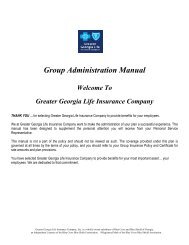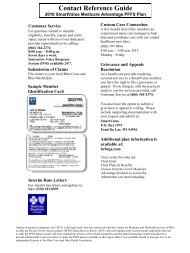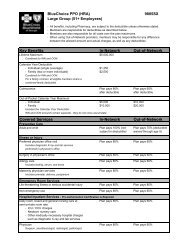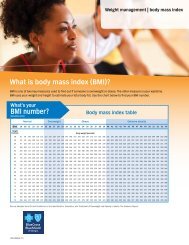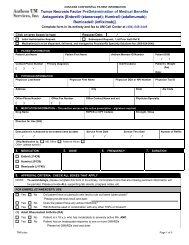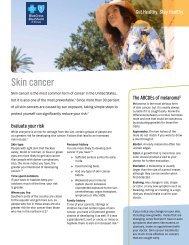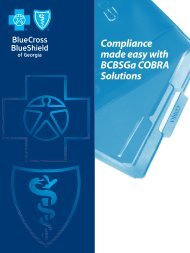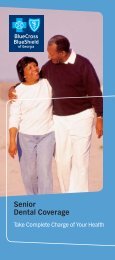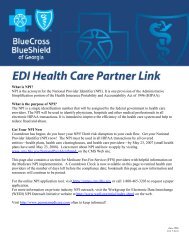Do Healthy Adults Need Checkups, Screening Tests, and Shots?
Do Healthy Adults Need Checkups, Screening Tests, and Shots?
Do Healthy Adults Need Checkups, Screening Tests, and Shots?
Create successful ePaper yourself
Turn your PDF publications into a flip-book with our unique Google optimized e-Paper software.
OsteoporosisThe CDC warns that osteoporosis, or thinning bones, increases the risk of fracture. This condition is more commonin women than in men due to the loss of estrogen after menopause. After age 55, a woman’s bones become moreporous. It is estimated that half of all women past the age of menopause will break a bone during their lifetime. Abone density test can help determine whether your bones are prone to breaking. If they are becoming thin, yourdoctor may prescribe medication to reduce your risk for fractures.The CDC recommends that women age 65 <strong>and</strong> older be tested regularly, or earlier if you are at increased risk forfractures - for example, if you have a small body frame or have a family history of the disease. Ask your doctor whenbone density testing is right for you.TuberculosisTuberculosis (TB) is an infection that affects the lungs <strong>and</strong> eventually other parts of the body. This infection can bepassed from one person to the next. It may be treated effectively if caught early. The CDC advises that you may beat risk for TB <strong>and</strong> may need a TB test if:• You have been in close contact with someone who has TB.• You have recently come to the U.S. from Asia, Africa, Central or South America, or the Pacific Isl<strong>and</strong>s.• You have kidney failure, diabetes, HIV, or alcoholism.• You have injected or currently inject street drugs.• <strong>Tests</strong> <strong>and</strong> <strong>Screening</strong> Exams to Find Certain CancersThe American Cancer Society (ACS) advises that certain screening tests <strong>and</strong> regular exams may help increase thechances of finding some cancers early. Many cancers may be treated more easily if they are diagnosed early.The tests you get <strong>and</strong> how often you get them may depend on age, health history, <strong>and</strong> risks, such as family history <strong>and</strong>lifestyle. The ACS offers some guidelines about what screenings are recommended to detect certain cancers.Colorectal Cancer <strong>Screening</strong>According to the ACS, colorectal (colon) cancer is the second leading cause of cancer deaths in the U.S. However,if colorectal cancer is detected early, it can be treated. <strong>Screening</strong> for colorectal cancer is recommended beginning atage 50. There are several different types of tests. You <strong>and</strong> your doctor can determine which test is best for you <strong>and</strong>how often.Tell your doctor if you have had polyps or if you have family members who have had colorectal cancer, breast cancer,or cancer of the ovaries or uterus. If so, you may need to be tested more often <strong>and</strong> at an earlier age.Breast Cancer <strong>Screening</strong>The ACS reports that breast cancer is the second most common cancer among women <strong>and</strong> the second leading causeof cancer death in women. Mammography screening is a very important tool for early detection of breast cancer. TheUSPSTF recommends women age 40 <strong>and</strong> older have a mammogram every one to two years. Women with a familyhistory of breast cancer should talk with their doctors about when to begin mammography screenings <strong>and</strong> clinicalbreast exams.Cervical Cancer <strong>Screening</strong>Regular pelvic exams <strong>and</strong> screening tests are the most accurate method for early detection of cervicalcancer. The Pap test is a procedure that is done during a pelvic exam. The Pap test can detect abnormal cell changesin the cervix that may be treated before they progress. Check with your doctor about a Pap test schedule that ismost appropriate for you. Current guidelines set by the USPSTF are:
• Young women should have their first Pap test three years after they begin having sexual intercourseor at age 21, whichever comes first.• Women should have a Pap test annually until age 30. Women 30 <strong>and</strong> older with negative results on threeconsecutive pap tests may be re-screened every 2-3 years.• Because most cervical cancers are caused by the human papillomavirus (HPV), the USPSTF recommends anHPV vaccination for girls <strong>and</strong> women age 11-26 to prevent cervical cancer. Ask your doctor about the HPVvaccine.Your doctor may suggest stopping Pap tests if:• You are older than 65, have had regular, normal Pap tests, <strong>and</strong> are not at increased risk for other reasons.• You have had a hysterectomy.Prostate Cancer <strong>Screening</strong>Prostate cancer is most common in men over age 50. You also may be at increased risk for prostate cancer if you areAfrican American or if your father or brother has had prostate cancer.<strong>Screening</strong> tests such as a PSA (prostate-specific antigen) blood test <strong>and</strong> a digital rectal exam may help detect prostatecancer. According to the ACS, screening can help doctors find <strong>and</strong> treat the cancer early. However, studies so far havenot shown that screening tests reduce the number of deaths from prostate cancer. Men should talk with their doctorabout risk factors, <strong>and</strong> the pros <strong>and</strong> cons of screening for prostate cancer.Oral Cancer <strong>Screening</strong>Oral cancer includes cancers of the lip, tongue, pharynx, <strong>and</strong> mouth. According to the ADA, most oral cancers canoccur in people over age 40 who use tobacco or alcohol. People who have more sun exposure may be at greater riskfor cancer of the lip. You can help prevent oral cancer by not smoking or abusing alcohol, <strong>and</strong> by using an SPF 15sun block on your lips. Your dentist can examine your mouth, lips, <strong>and</strong> tongue for signs of cancer during your regularexams. Talk to your dentist about risk factors for oral cancer.• <strong>Shots</strong> to Prevent DiseasesVaccines aren’t just for kids. The CDC warns that far too many adults become ill, are disabled, <strong>and</strong> die each yearfrom diseases that could easily have been prevented by vaccines. Here are some of the important recommendedimmunizations for adults:Measles-Mumps-Rubella ShotIf you have never had a measles-mumps-rubella shot or never had measles, mumps, <strong>and</strong> rubella, the CDC advisesreceiving at least one dose of this vaccine if:• You are a woman <strong>and</strong> able to become pregnant.• You were born after 1956.This shot is especially important for women of child-bearing age. If a pregnant woman gets rubella, she could have amiscarriage, or her baby could have birth defects.Tetanus-Diphtheria ShotTetanus (lockjaw) <strong>and</strong> diphtheria are serious diseases. The CDC explains that diphtheria spreads when germs passfrom an infected person to the nose or throat of others. Tetanus is caused by a germ that may enter the body througha cut or wound in the skin. To prevent the potential serious health complications of these diseases, most people needa booster shot every 10 years.
Flu Prevention – Important Information for You <strong>and</strong> Your FamilyIt’s that time of year again - upper respiratory viruses are beginning to spread in schools, in the workplace, <strong>and</strong> athome. It’s hard to avoid catching the common cold, but the flu is more serious <strong>and</strong> has a greater risk of health complications.Fortunately, we can protect our families <strong>and</strong> ourselves from the flu virus.What is the Flu?According to the Centers for Disease Control <strong>and</strong> Prevention (CDC), the flu, also known as influenza, is a contagiousdisease caused by the influenza virus. It attacks the respiratory tract (nose, throat, <strong>and</strong> lungs) in humans.The CDC reports that millions of people in the United States get influenza – about 10%-20% of the population– every year. Most people who get the flu will recover in one to two weeks, but some people can develop life-threateningcomplications such as pneumonia. The CDC estimates that about 36,000 Americans die from the flu everyyear <strong>and</strong> another 200,000 are hospitalized as a result of flu complications.When is Flu Season?According to the CDC, winter is flu season in the northern hemisphere. In the U.S., the flu season can range fromNovember through March, <strong>and</strong> sometimes into early spring.What Are the Symptoms of the Flu?The CDC states that flu symptoms usually occur suddenly <strong>and</strong> mayinclude the following:• Fever• Headache• Fatigue (can be extreme)• Dry cough• Sore throat• Nasal congestion• Body achesHow is the Flu Spread?The CDC explains that flu germs can spread before symptomseven begin to appear. <strong>Adults</strong> can spread the virus to others foranother three to seven days after symptoms have developed. Childrencan spread the flu virus to others for more than seven days.Some people can be infected with the flu <strong>and</strong> have no symptoms;however, they can still spread the virus to others.According to the CDC, flu viruses are most commonly spread fromperson to person by coughs <strong>and</strong> sneezes. This “droplet spread” occurs when droplets of mucous from a cough orsneeze of an infected person are carried through the air (usually up to three feet) <strong>and</strong> come in contact with the mouthor nose of another person. The viruses can also be spread when people touch droplets on another person or anobject <strong>and</strong> then touch their own eyes, mouths, or noses before washing their h<strong>and</strong>s.
Am I at Risk?ANYONE can get the flu – even healthy people. However, some individuals are more likely to develop complications,such as pneumonia. Persons at high risk include those age 65 years <strong>and</strong> older, people of any age with a chronicillness, <strong>and</strong> very young children. In addition, a recent study reported in the European Heart Journal found that flu canworsen heart disease, <strong>and</strong> that deaths from heart attacks <strong>and</strong> heart disease increase during the flu season.How Can I Protect Myself From Getting the Flu?According to the CDC, the best method of protection from the flu is to get vaccinated every year. Beginning in earlyFall, the flu shot is offered to people at high risk. For those who are not high risk, the best time to get vaccinated isfrom October to December. You should get the vaccine annually because flu viruses are different every year. Thevaccine is usually available at your doctor’s office, local clinics, certain community centers, workplaces, supermarkets,<strong>and</strong> some drugstores.Types of Vaccines• The flu vaccine contains 3 dead or inactivated influenza viruses <strong>and</strong> is usually given by an injection in thearm.• In 2003, the Food <strong>and</strong> Administration (FDA) approved a nasal spray flu vaccine called FluMist ® . Thisvaccine contains weakened, live influenza viruses <strong>and</strong> is recommended for healthy people, ages 5 to 49 years. Itis not recommended for pregnant women. Talk to your doctor if you would like more information aboutFluMist ® . (Be sure to check if FluMist ® is a covered benefit under your health plan).Who Should Get the Flu Vaccine?The CDC recommends that you get a flu shot every year if you are at higher risk for getting the flu or developing flucomplications. You are considered to be at higher risk if:• You are age 50 or older.• You have one or more chronic diseases involving your heart, lungs, or kidneys.• You have diabetes.• Your immune system does not function properly.• You have a severe form of anemia.• You are pregnant during the flu season (November-March).• You are living in a nursing home or other chronic-care housing facility.• You are living in a household with any of the above.• You are a household contact or an out-of-home caregiver of babies 0-6 months.Note: You should NOT get a flu shot if you have any of the following conditions:• History of Guillain-Barré Syndrome.• History of allergy or hypersensitivity to eggs.• Previous allergic reaction to a flu shot.• A fever. Talk to your doctor about postponing your flu shot until you are well.
Should My Children Be Immunized Every Year?In 2006, the CDC added the recommendation that children 6 months to 59 months of age be immunized each year. TheCDC recommends that adults have a flu shot if they are in close contact with children in this age group. Children <strong>and</strong>teenagers (ages 6 months to 18 years) should get the flu vaccine if they are taking long-term aspirin treatment. Childrenshould also be immunized if they live in a household with someone in the groups listed above. Children who areunder 9 years of age <strong>and</strong> have never had a flu shot will need 2 shots, one month apart, before the flu season begins.Note: For recent updates or changes in vaccine recommendations, check with your doctor or the CDC’s website:http://www.cdc.gov.Taking Care of YourselfThe CDC recommends additional ways to prevent the flu:• Avoid close contact with people who are sick.• Wash your h<strong>and</strong>s often with soap <strong>and</strong> hot water; this will help protect you from germs.• Avoid touching your eyes, nose, or mouth; this is how germs are spread.• Keep your immune system strong by eating a healthy diet <strong>and</strong> exercising regularly.The CDC advises taking the following precautions if you get sick:• Get plenty of rest.• Drink a lot of fluids.• Avoid using alcohol <strong>and</strong> tobacco.• Ask your doctor about over-the-counter medications. Remember, antibiotics cannot treat cold <strong>and</strong> fluviruses.Note: Never give aspirin to children or teenagers to relieve the symptoms of flu. A serious neurological condition called Reyes syndromemay develop in children who take aspirin to relieve fever <strong>and</strong> other flu symptoms.• Stay home <strong>and</strong> avoid contact with other people to prevent spreading the virus.• Cover your mouth <strong>and</strong> nose with a tissue when coughing or sneezing. It may prevent others from gettingsick.• If you are high-risk, contact your doctor immediately.Watch for Warning SignsIf you have the flu, the CDC lists warning signs that would require immediate medical attention:Children:• High or prolonged fever• Fast breathing or difficulty breathing• Bluish skin color• Not drinking enough fluids• Changes in behavior or mental state such as extreme lethargy or not interacting, extreme irritability, refusingto be held, or seizures• Flu-like symptoms improve but then return with fever <strong>and</strong> severe cough• Worsening of any chronic medical conditions
<strong>Adults</strong>:• High or prolonged fever• Difficulty breathing or shortness of breath• Pain or pressure in the chest• Feeling faint, or fainting• Confusion• Severe or persistent vomitingIf you or anyone in your family experiences any of these signs, call your doctor or go to an emergency room immediately.If you have questions or concerns about the flu <strong>and</strong> the flu vaccine, talk to your doctor. You may also visit the CDCwebsite http://www.cdc.gov/flu/ or call the CDC influenza hotline at 800-232-2522.Note: For health benefit eligibility, check your Evidence of Coverage <strong>and</strong>/or contact the customer service number locatedon the back of your ID card.Checking Up on CholesterolEvery September, the Centers for Disease Control’s National Cholesterol Education Program (NCEP) sponsors NationalCholesterol Education Month to increase cholesterol awareness. This important health campaign stresses theimportance of underst<strong>and</strong>ing your cholesterol levels <strong>and</strong> learning how to achieve or maintain healthy levels.High blood cholesterol is a major risk factor for cardiovascular (heart <strong>and</strong> blood vessel) disease, the leading cause ofdeath in the United States. According to the Centers for Disease Control <strong>and</strong> Prevention (CDC), almost 100 millionAmerican adults have high cholesterol.What Is Cholesterol?The National Heart, Lung, <strong>and</strong> Blood Institute (NHLBI) describes cholesterol as a waxy, fat-like substance that isfound in all cells of the body. Your body uses cholesterol to make hormones, vitamin D, <strong>and</strong> substances that help youdigest foods. Your body needs some cholesterol to function well, but according to the NHLBI, too much cholesterolin the blood, or high blood cholesterol, can lead to serious health problems.Checking Your CholesterolThere are usually no signs or symptoms of high cholesterol. Many people may not know that their cholesterol levelis too high. That is why it is important to have regular cholesterol checks. High blood cholesterol can be diagnosedby a blood test that measures the levels of cholesterol in your blood. The CDC <strong>and</strong> the NHLBI recommend thateveryone age 20 <strong>and</strong> older have their cholesterol checked at least once every 5 years. You <strong>and</strong> your doctor can discusshow often you should be tested.
What are the Recommended Cholesterol Levels?According to the NCEP, desirable or optimal blood cholesterol levels for persons with or without existing heartdisease are:• Total cholesterol: Less than 200 mg/dL.• Low Density Lipoprotein (LDL) cholesterol ("bad" cholesterol): Less than 100 mg/dL.• High Density Lipoprotein (HDL) cholesterol ("good" cholesterol): 40 mg/dL or higher.• Triglycerides (another form of fat in the blood): Less than 150 mg/dL.Unfortunately, of the 100 million American adults who have high blood cholesterol (total blood cholesterol levelsof 200 milligrams per deciliter (mg/dL) or higher), an estimated 34.5 million persons have levels of 240 mg/dL orabove.What Causes High Blood Cholesterol?There are several factors that can affect the cholesterol levels in your blood. The NCEP lists some of the factors youcan control <strong>and</strong> others you cannot control:You Can Control:• What You Eat. Many foods have certain types of fats that may raise cholesterol levels.• Saturated fat is the main dietary cause of high blood cholesterol. The American Heart Association (AHA)warns that saturated fat can raise your LDL cholesterol level more than anything else in your diet. Saturatedfats are mostly found in foods that come from animal sources, such as beef, veal, lamb, pork, butter, cream,whole milk, hard cheeses <strong>and</strong> other dairy products made from whole milk. Saturated fat is also found insome plant products including coconut oil, palm oil, <strong>and</strong> cocoa butter.• Trans-fatty acids (trans-fats) are found in various animal products such as beef, pork, lamb, <strong>and</strong> the butterfatin butter <strong>and</strong> milk. Trans-fats are also found in foods (especiallyfast foods) cooked with hydrogenated vegetable oils.Hydrogenated vegetable oils provide about three-fourths oftrans-fats in American diets. Margarine, shortening, cookingoils <strong>and</strong> the foods made from them are a major source oftrans-fats. According to the AHA, clinical studies haveshown that trans-fats tend to raise LDL (“bad”) cholesterol,<strong>and</strong> lower HDL (“good”) cholesterol, <strong>and</strong> can increase totalblood cholesterol levels even more than saturated fats.Note: Read food labels! Since January 2006 the FDA has requiredtrans-fats to be listed on nutrition labels.• Your Weight. Being overweight tends to increase your LDL cholesterol level, lower your HDL cholesterollevel, <strong>and</strong> increase your total cholesterol level.• Your Activity. Lack of regular exercise can lead to weight gain, which could raise your LDL cholesterol level.Regular exercise can help you lose weight, lower your LDL cholesterol level, <strong>and</strong> raise your HDL cholesterollevel.You Cannot Control:• Heredity. High blood cholesterol can run in families.• Age <strong>and</strong> Sex. As women <strong>and</strong> men get older, their LDL cholesterol levels tend to rise. Most young women havelower LDL cholesterol levels than men, but after age 55, women’s LDL cholesterol levels tend to rise higherthan men’s.
How Is High Blood Cholesterol Treated?The AHA explains that the main goal of cholesterol treatment is to lower cholesterol - in particular the LDL level– to normal limits to help reduce the risk of heart attack, stroke, <strong>and</strong> other cardiovascular diseases. The higher theLDL level <strong>and</strong> the more risk factors you have, the greater the risk may be for developing a serious health problem.Cholesterol levels can be lowered through lifestyle changes including dietary improvement, increased physical activity,weight control, <strong>and</strong> by prescribed medications.Lifestyle Changes to Lower CholesterolThe NHLBI recommends the following lifestyle changes to help lower your cholesterol:Diet• Limit the amount of saturated fat, trans-fats, <strong>and</strong> cholesterol in your food.• Eat only enough calories to achieve or maintain a healthy weight.• Increase the soluble fiber in your diet. For example, oatmeal, kidney beans, <strong>and</strong> apples are goodsources of soluble fiber.Weight ManagementPhysical Activity• Losing weight if you are overweight can help lower cholesterol.• Weight management is especially important for persons with several risk factors that include hightriglyceride <strong>and</strong>/or low HDL levels, <strong>and</strong> being overweight with a large waist measurement (more than40 inches for men <strong>and</strong> more than 35 inches for women).• Regular physical activity is recommended for most people to control cholesterol.• Exercise can help raise HDL levels <strong>and</strong> lower LDL levels, <strong>and</strong> is especially important for those withhigh triglyceride <strong>and</strong>/or low HDL levels <strong>and</strong> are overweight with a large waist measurement.• For exercise ideas, check out:September 24 - America on the Move Day http://www.americaonthemove.orgSeptember 29 - Family Health <strong>and</strong> Fitness Day http://www.fitnessday.comTalk to your doctor about what lifestyle changes you can make to help lower <strong>and</strong> maintain optimal cholesterol levels.Cholesterol-Lowering MedicinesAlong with diet <strong>and</strong> physical activity changes, your doctor may prescribe drugs (statins or other types of drugs) tohelp lower your cholesterol. Even if you take these medications, you will always need to continue your healthy lifestylemodifications. Drug treatment may control, but does not “cure” high blood cholesterol. The AHA advises thatyou always take your medication as directed to keep your cholesterol level in the recommended range. When you areunder treatment, you may be checked regularly to make sure your cholesterol level is controlled.When trying to lower your cholesterol or keep it low, it is important to remember to follow your treatment recommendationsfor other conditions you may have, such as high blood pressure. Get help with quitting smoking <strong>and</strong> losingweight if they are risk factors for you.
A Note about Healthier Dieting…..If you think that classic high-cholesterol dishes such as macaroni <strong>and</strong> cheese can’t be modified for a heart-healthy diet,see below. The NHBLI offers a variety of yummy low-cholesterol recipes on its “Stay Young at Heart” website link.Check it out at: http://www.nhlbi.nih.gov/health/public/heart/other/syah/index.htm.CLASSIC MACARONI AND CHEESELow fat cheese <strong>and</strong> skim milk help to make this favorite dish heart-healthy.2 cups macaroni1/2 cup chopped onions1/2 cup evaporated skim milk1 medium egg, beaten (or egg substitute)1/4 tsp black pepper1 1/4 cups sharp low fat cheddar cheese (4 oz), finely shreddednonstick cooking oil spray1. Cook macaroni according to directions. (<strong>Do</strong> not add salt to the cooking water) Drain <strong>and</strong> set aside.2. Spray a casserole dish with nonstick cooking oil spray. Preheat oven to 350° F.3. Lightly spray saucepan with nonstick cooking oil spray.4. Add onions to saucepan <strong>and</strong> sauté for about 3 minutes.5. In another bowl, combine macaroni, onions, <strong>and</strong> the remaining ingredients <strong>and</strong> mix thoroughly.6. Transfer mixture into casserole dish.7. Bake for 25 minutes or until bubbly. Let st<strong>and</strong> for 10 minutes before serving.Makes 8 servings--Serving size: 1/2 cupCalories 200Fat 4 gSaturated fat 2 gCholesterol 34 mgSodium 120 mgFor more information about high blood cholesterol:National Heart Lung Blood Institute (NHLBI)High Blood Cholesterol - What You <strong>Need</strong> to Knowhttp://www.nhlbi.nih.gov/health/public/heart/chol/hbc_what.htm.
Beware of Email Health HoaxesLegend:Status:The Truth:Improved technology <strong>and</strong> the wide use of the Internet has made gatheringinformation easier than ever before. With the help of one of many searchengines available, you can quickly <strong>and</strong> easily obtain information on everythingfrom a recipe for chocolate chip cookies to the causes <strong>and</strong> treatmentsof a multitude of medical conditions. However, the Centers for DiseaseControl <strong>and</strong> Prevention (CDC) warns that not all information found onlineis accurate, especially medical information in forwarded emails.According to the U.S. Department of Energy’s Computer Incident AdvisoryCapability (CIAC), increased worldwide use of the Internet <strong>and</strong> email hasgiven rise to a proliferation of “urban legends” <strong>and</strong> misinformation in theform of email hoaxes. For example, email “scares” about poisoned foodproducts have increased since 9/11. Many email hoaxes appear very credible<strong>and</strong> are often forwarded by well-meaning friends <strong>and</strong> family members.The CIAC tracks <strong>and</strong> archives email hoaxes on their Hoaxbusters website.This website contains information about hoaxes, chain letters, urban myths,<strong>and</strong> other bogus information that is routed around the Internet. Here aresome examples from the CIAC of the most widespread health-relatedhoaxes:Plastic Wrap in the Microwave Causes Toxins to Enter Your Food!FALSEAccording to the Johns Hopkins School of Public Health, there is no evidence to suggest that using plastic wrap toheat food in the microwave poses any kind of threat.Legend:Status:The Truth:Freezing Water in Plastic Water Bottles Transfers Deadly Toxins to the Water!FALSEFreezing actually works against the release of chemicals, according to Johns Hopkins. Chemicals do not diffuse asreadily in cold temperatures, which would limit chemical release if there were dioxins in plasticIn general, the United States Food <strong>and</strong> Drug Administration (FDA) has reported that there is no evidence that plasticfood <strong>and</strong> beverage containers contain dangerous toxins. In fact, the FDA posted an article in 2002 in response to thismisinformation, <strong>and</strong> is still receiving inquiries today. To view the entire article <strong>and</strong> more information on microwavecontainer safety, visit this FDA website: http://www.fda.gov/fdac/features/2002/602_plastic.html.Legend:Status:The Truth:Bananas Cause Necrotizing Fasciitis (Flesh Eating Virus)!FALSENecrotizing fasciitis is a real disease, <strong>and</strong> very serious. This rare bacterial infection can destroy skin <strong>and</strong> the soft tissuesbeneath it (fascia). Necrotizing fasciitis can be caused by several kinds of bacteria, including Group A Streptococcus.However, the email is a hoax.
The CDC <strong>and</strong> the FDA released a joint statement regarding this hoax: “The bacteria which most commonly causenecrotizing fasciitis frequently live in the human body. The usual route of transmission for these bacteria is fromperson to person. Sometimes they can be transmitted in foods, but this would be an unlikely cause for necrotizingfasciitis. The CDC <strong>and</strong> the FDA agree that the bacteria cannot survive long on the surface of a banana.”According to the CDC, the spread of all types infections can be reduced by good h<strong>and</strong> washing, especially aftercoughing <strong>and</strong> sneezing <strong>and</strong> before preparing foods or eating. For more information on Group A streptococcus,please visit the Division of Bacterial <strong>and</strong> Mycotic Diseases page on the CDC website: http://www.cdc.gov/ncidod/dbmd/diseaseinfo/groupastreptococcal_g.htmLegend:Status:The Truth:Want to Know How to Survive a Heart Attack if You are Alone? Give Yourself CPR by Coughing!FALSEBoth the American Heart Association <strong>and</strong> the American Red Cross say this method of CPR is highly unlikely to saveanyone. If your heart has stopped you are going to pass out in a matter of seconds. If you have not passed out, yourheart has not stopped <strong>and</strong> you do not need CPR. You will have a much higher survival probability if you dial 911 immediatelyat the first signs of a possible heart attack. To learn the warning signs of a heart attack, visit the AmericanHeart Association website at http://www.americanheart.com.Legend:Status:The Truth:Aspartame Causes Cancer in Humans!FALSEAspartame is a safe <strong>and</strong> approved artificial sweetener. The FDA issued a statement denying these rumors back in 1996– <strong>and</strong> again in 2007 - st<strong>and</strong>ing behind their decision to approve Aspartame for use in the United States. You can readthe FDA statement by visiting the following website: http://www.aspartame.net/OnPagePDF/FDA%20Statement.pdf.According to the American Dietetic Association (ADA), aspartame’s safety has been documented in more than 200studies. Regulatory authorities in more than 100 countries, including the FDA, the World Health Organization, <strong>and</strong>the European Commission’s Scientific Committee on Food, have confirmed the safety of aspartame. You can readthe entire ADA statement by visiting the following website at: http://www.aspartame.org/APMJADA_factsheet_2006.pdf.Legend:Status:The Truth:Antiperspirants Clog Sweat Gl<strong>and</strong>s <strong>and</strong> Cause Breast Cancer!FALSEPlugging up the sweat gl<strong>and</strong>s under your arms cannot cause breast cancer. The American Cancer Society has debunkedthis message.Legend:Status:The Truth:Tampons Contain Asbestos <strong>and</strong> Dioxin (a Toxic Chemical) to Increase Bleeding!FALSEWhile there may be risks with using tampons, these risks are not associated with any possible asbestos or dioxincontent in the tampons, according to the FDA.
Legend: Canola Oil is Hazardous to Your Health!Status: FALSEThe Truth:According to the Mayo Clinic, negative reports circulating on the Internet about canola oil are unfounded. This misinformationmay stem from the fact that, years ago, oil was produced from the rapeseed plant. Rapeseed oil is high inerucic acid, a compound that does have some adverse health effects. For this reason, plant breeders developed a newplant that is similar to the rapeseed plant but contains very low levels of erucic acid. The new oil was called “canola”oil <strong>and</strong> contains well below the 2 percent limit set by the FDA. It is approved for cooking <strong>and</strong> salad dressings. Canolaoil has a balanced blend of omega-3 fatty acids, omega-6 fatty acids, <strong>and</strong> monounsaturated fats, <strong>and</strong> has the leastamount of saturated fat of all the cooking oils available.When in <strong>Do</strong>ubt, Check it OutBecause most email pranksters are very good at what they do, spotting a hoax can be difficult. The CIAC warns usto be especially wary of any health-related information received in an email. Most importantly, never act on “medicalinformation” without first verifying its accuracy. Visit the CIAC Hoaxbusters website at http://hoaxbusters.ciac.org/for information on email hoaxes - how to recognize them, <strong>and</strong> how to report them. <strong>Do</strong> NOT spread misinformationby forwarding non-validated emails to others.Remember, your doctor is your best source for medical advice. If you use the Internet to obtain medical information,make sure you use a reliable source, such as the CDC at http://www.cdc.gov, <strong>and</strong> the FDA at http://www.fda.gov.You can find valuable information, tools for managing your health, <strong>and</strong> support for those who seek information onyour health plan’s website as well.
Pregnancy Pointers: Preventing Infections During PregnancyInfections can be dangerous when you are pregnant. The Centers for Disease Control <strong>and</strong> Preventionoffers10 tips to help you prevent infections that may harm your unborn baby:1. Wash your h<strong>and</strong>s often with soap <strong>and</strong> water, especially when:• Using the bathroom• Touching raw meat, raw eggs, or unwashed vegetables• Preparing <strong>and</strong> eating food• Gardening or touching dirt or soil• H<strong>and</strong>ling pets• Being around people who are sick• Getting saliva on your h<strong>and</strong>s• Caring for <strong>and</strong> playing with children• Changing diapers(If soap <strong>and</strong> running water are not available, you may use alcohol-based h<strong>and</strong> gel)2. Try not to share forks, cups, or food with young children. Wash your h<strong>and</strong>s often whenaround children. Their saliva <strong>and</strong> urine may contain a virus that can be dangerous for you <strong>and</strong> yourunborn baby.3. Cook meat until it’s well done. The juices should run clear <strong>and</strong> there should be no pink inside. Undercookedmeats <strong>and</strong> processed meats may contain harmful bacteria. <strong>Do</strong> not eat hot dogs, luncheon meats, or deli meats, unlessthey are steaming hot.4. Avoid unpasteurized (raw) milk <strong>and</strong> foods made from raw milk. Unpasteurized products can contain harmfulbacteria. <strong>Do</strong> not eat soft cheeses such as feta, brie, <strong>and</strong> queso fresco unless they have labels that say they arepasteurized.5. <strong>Do</strong> not touch or change dirty cat litter. Dirty cat litter may contain a harmful parasite. If you must change thelitter yourself, be sure to wear gloves <strong>and</strong> wash your h<strong>and</strong>s afterwards.6. Stay away from wild or pet rodents <strong>and</strong> their droppings. Some rodents can carry a harmful virus. If you havea pet rodent such as a hamster or guinea pig, have someone else care for it until after your pregnancy.7. Get tested for sexually transmitted diseases (STDs), including HIV, <strong>and</strong> protect yourself from STDs.Knowing whether or not you have an STD is important. If you do have an STD, talk to your doctor about how youcan reduce the chance that your baby will become sick.8. Talk to your doctor about vaccinations (shots). Having the right vaccinations at the right time can help keep youhealthy <strong>and</strong> help keep your baby from getting very sick or having life-long health problems.9. Avoid people who have an infection or virus. Stay away from people who are sick. Wash your h<strong>and</strong>s often.10. Ask your doctor about group B strep. About 1 in 4 women carry this type of bacteria, but do not feel sick. Asimple test can determine if you have this bacteria.You won’t always know if you have an infection—sometimes you won’t even feel sick. If you think you may have aninfection or think you are at risk, see your doctor.Source: Centers for Disease Control <strong>and</strong> Prevention
Important News!Blue Cross <strong>and</strong> Blue Shield of Georgia announces Future Moms,a prenatal education program designed to help youhave a healthy pregnancy <strong>and</strong> a healthy baby.Please call 800-814-1508 or contact yourcustomer service representative for more information.Smoking FactsDid you know….. The sooner you give up smoking, the better it is for your blood vessels <strong>and</strong> arteries. Hardenedarteries due to smoking can increase blood pressure <strong>and</strong> boost the risk of cardiovascular problems such asheart attack <strong>and</strong> stroke. However, smoke-stiffened arteries may slowly regain healthy flexibility if smokers kickthe habit, according to a new study published in the March 2007 issue of Hypertension, a clinical journal. Whatresearchers found was that blood vessels regained their flexibility in direct proportion to the length of timepassed since that last cigarette. Be aware that if you have smoked for a long time, it will take a longer timefor your blood vessels to get back to more normal function.Another clinical study, published in the March 2007 Archives of Dermatology, reported that smoking addsyears to the skin, even skin that is not normally exposed to sunlight. The researchers found that the totalnumber of packs of cigarettes smoked per day <strong>and</strong> the total number of years a person has smoked werelinked with the amount of skin damage a person experienced.There are lots of reasons for giving up smoking – these are just two of them.Sources: Archives of Dermatology, March 2007Hypertension, March 2007For information to help you quit smoking, please visit the following website: www.smokefree.gov, or call the National Networkof Tobacco Cessation Quitlines at 1-800-QUITNOW (1-800-784-8669) TTY 1-800-332-8615.
This information is intended for educational purposes only, <strong>and</strong> should not be interpreted as medical advice.Please consult your doctor for advice about changes that may affect your health. Trade names of commonly usedmedications <strong>and</strong> devices are provided for ease of education but are not intended as particular endorsements.Your doctor may choose to use items not represented here. Some services may not be covered under your healthplan. Please refer to your Health Plan Group Certificate <strong>and</strong> Schedule of Benefits for details concerningbenefits, procedures, <strong>and</strong> exclusions. This newsletter <strong>and</strong> your health plan company are not affiliated with orresponsible for information provided by resources cited in the articles.Women’s Health e-NewsletterManaging EditorCherri Straus, MPHContributorsCherri Straus, MPHMarcy <strong>Do</strong>nleyDesign CoordinatorsBrian MacrenarisRhonda WolberdPhysician ReviewerLora Abell, MDFor more information about Women’s Health or other products <strong>and</strong> services offered by Blue Cross <strong>and</strong> Blue Shieldof Georgia, visit our Web site at http://w3.bcbsga.com/healthyLiving/womensHealth/.To UNSUBSCRIBE from this mail list, simply click on the link below <strong>and</strong> then click send.WH_BCBSGA-SIGNOFF-REQUEST@LIST.BCBSGA.COMPlease Note: Unless otherwise stated in the linked Web sites, the entities delivering the referenced linked Web sitesare not affiliates of Blue Cross <strong>and</strong> Blue Shield of Georgia. Blue Cross <strong>and</strong> Blue Shield of Georgia exerts no controlover the linked Web sites <strong>and</strong> assumes no responsibility for any information or other content located on thelinked Web sites, or any subsequently linked Web sites. Blue Cross <strong>and</strong> Blue Shield of Georgia makes no endorsementof the entities sponsoring the linked Web sites.Blue Cross Blue Shield of Georgia is an independent licensee of the Blue Cross <strong>and</strong> Blue Shield Association.



